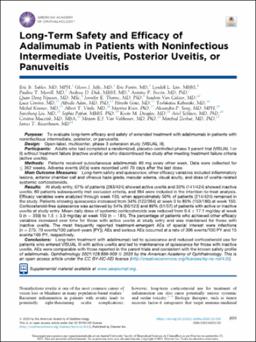| dc.contributor.author | Schlaen, Ariel. | |
| dc.contributor.author | Suhler, Eric. | |
| dc.contributor.author | Jaffe, Glenn. | |
| dc.contributor.author | Et al. | |
| dc.date.accessioned | 2023-09-25T15:11:00Z | |
| dc.date.available | 2023-09-25T15:11:00Z | |
| dc.date.issued | 2021-06 | |
| dc.identifier.citation | Ophthalmology . 2021 Jun;128(6):899-909. | es |
| dc.identifier.issn | 0161-6420/20 | |
| dc.identifier.uri | https://riu.austral.edu.ar/handle/123456789/2299 | |
| dc.description | Disponible en: https://www.clinicalkey.es/#!/content/playContent/1-s2.0-S0161642020310381?returnurl=https:%2F%2Flinkinghub.elsevier.com%2Fretrieve%2Fpii%2FS0161642020310381%3Fshowall%3Dtrue&referrer=https:%2F%2Fpubmed.ncbi.nlm.nih.gov%2F | es |
| dc.description.abstract | Abstract
Purpose: To evaluate long-term efficacy and safety of extended treatment with adalimumab in patients with noninfectious intermediate, posterior, or panuveitis.
Design: Open-label, multicenter, phase 3 extension study (VISUAL III).
Participants: Adults who had completed a randomized, placebo-controlled phase 3 parent trial (VISUAL I or II) without treatment failure (inactive uveitis) or who discontinued the study after meeting treatment failure criteria (active uveitis).
Methods: Patients received subcutaneous adalimumab 40 mg every other week. Data were collected for ≤ 362 weeks. Adverse events (AEs) were recorded until 70 days after the last dose.
Main outcome measures: Long-term safety and quiescence; other efficacy variables included inflammatory lesions, anterior chamber cell and vitreous haze grade, macular edema, visual acuity, and dose of uveitis-related systemic corticosteroids.
Results: At study entry, 67% of patients (283/424) showed active uveitis and 33% (141/424) showed inactive uveitis; 60 patients subsequently met exclusion criteria, and 364 were included in the intention-to-treat analysis. Efficacy variables were analyzed through week 150, when approximately 50% of patients (214/424) remained in the study. Patients showing quiescence increased from 34% (122/364) at week 0 to 85% (153/180) at week 150. Corticosteroid-free quiescence was achieved by 54% (66/123) and 89% (51/57) of patients with active or inactive uveitis at study entry. Mean daily dose of systemic corticosteroids was reduced from 9.4 ± 17.1 mg/day at week 0 (n = 359) to 1.5 ± 3.9 mg/day at week 150 (n = 181). The percentage of patients who achieved other efficacy variables increased over time for those with active uveitis at study entry and was maintained for those with inactive uveitis. The most frequently reported treatment-emergent AEs of special interest were infections (n = 275; 79 events/100 patient-years [PY]); AEs and serious AEs occurred at a rate of 396 events/100 PY and 15 events/100 PY, respectively.
Conclusions: Long-term treatment with adalimumab led to quiescence and reduced corticosteroid use for patients who entered VISUAL III with active uveitis and led to maintenance of quiescence for those with inactive uveitis. AEs were comparable with those reported in the parent trials and consistent with the known safety profile of adalimumab.
Keywords: Adalimumab; Noninfectious uveitis; Uveitis; treatment-emergent adverse event.
Copyright © 2020 American Academy of Ophthalmology. Published by Elsevier Inc. All rights reserved. | es |
| dc.language.iso | en | es |
| dc.rights | Attribution-NonCommercial-NoDerivatives 4.0 Internacional | * |
| dc.rights.uri | http://creativecommons.org/licenses/by-nc-nd/4.0/ | * |
| dc.subject | Adalimumab. | es |
| dc.subject | Noninfectious uveitis. | es |
| dc.subject | Uveitis. | es |
| dc.title | Long-Term Safety and Efficacy of Adalimumab in Patients with Noninfectious Intermediate Uveitis, Posterior Uveitis, or Panuveitis | es |
| dc.type | Article | es |


